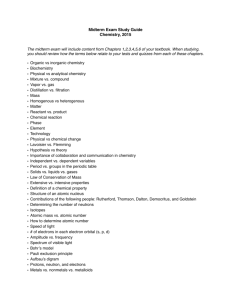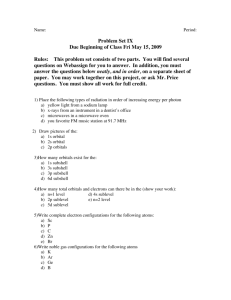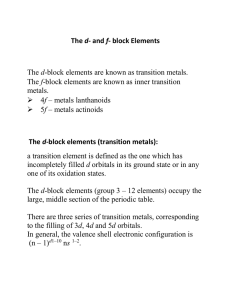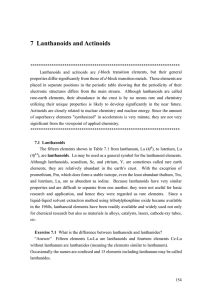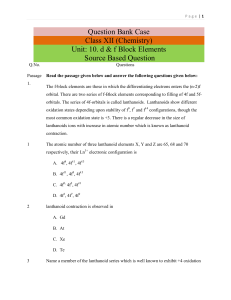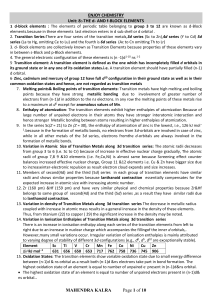d and f block elements A brief review
advertisement
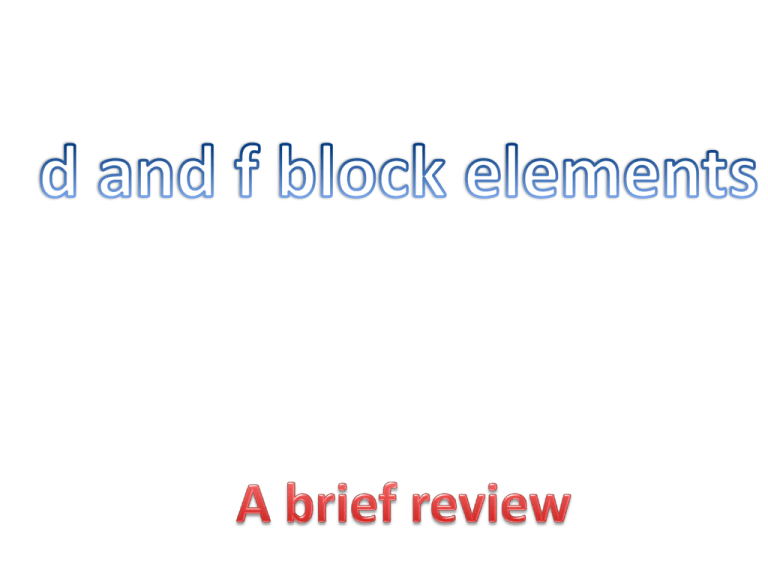
The names transition metals and inner transition metals are often used to refer to the elements of d-and f-blocks respectively. Zn , Cd and Hg are usually not considered as transition elements due to the absence of unpaired elements in d orbital The transition elements show variable oxidation state due to small energy difference between (n-1)d &ns orbital as a result both (n-1)d &ns electrons take part in bond formation. The high melting points of these metals are attributed to the involvement of greater number of electrons from (n-1)d in addition to the ns electrons in the interatomic metallic bonding. In any row the melting points of these metals rise to a maximum at d5 except for anomalous values of Mn and Tc and fall regularly as the atomic number increases. Greater the number of valence electrons, stronger is the resultant bonding. Since the enthalpy of atomisation is an important factor in determining the standard electrode potential of a metal, metals with very high enthalpy of atomisation (i.e., very high boiling point) tend to be noble in their reactions The shielding effect of a d electron is not that effective, hence the net electrostatic attraction between the nuclear charge and the outermost electron increases and the ionic radius decreases. The filling of 4f before 5d orbital results in a regular decrease in atomic radii called Lanthanoid contraction which essentially compensates for the expected increase in atomic size with increasing atomic number. The net result of the lanthanoid contraction is that the second and the third d series exhibit similar radii (e.g., Zr 160 pm, Hf 159 pm) and have very similar physical and chemical properties much more than that expected on the basis of usual family relationship. The unique behaviour of Cu, having a positive E, accounts for its inability to liberate H2 from acids. Only oxidising acids (nitric and hot concentrated sulphuric) react with Cu, the acids being reduced. The high energy to transform Cu(s) to Cu2+(aq) is not balanced by its hydration enthalpy. The general trend towards less negative E values across the series is related to the general increase in the sum of the first and second ionisation enthalpies. The value of E for Mn, Ni and Zn are more negative than expected from the trend. Paramagnetism arises from the presence of unpaired electrons, each such electron having a magnetic moment associated with its spin angular momentum and orbital angular momentum. The magnetic moment is determined by the number of unpaired electrons and is calculated by using the ‘spin-only’ formula, i.e., μ = n(n + 2) where n is the number of unpaired electrons and μ is the magnetic moment in units of Bohr magneton (BM). POTASSIUM DICHROMATE:-Preparation: - It takes place in three steps- •Conversion of chromite ore to sodium chromate. •Conversion of sodium chromate to sodium dichromate. •Conversion of sodium dichromate to potassium dichromate Following reaction take place:-4 FeCr2O4+ 4 Na2CO3 +7O2 2Na2CrO4 + 2 H+ Na2Cr2O7 + 2 KCl 2 Na2CrO4+ 2Fe2O3 +8 CO2 Na2Cr2O7 + 2 Na+ + H2O K2Cr2O7 + 2 NaCl POTASSIUM PERMANGNATE:-Preparation: -It takes place in two steps:- •Conversion of pyrolusite ore into potassium mangnate •Conversion of potassium mangnate to potassium permanganate Following reactions take place:- 2 MnO2 + 4 KOH + O2 3 MnO4 2- +4H+ 2 K2MnO4 + 2H2O 2 MnO4- +MnO2 +2H2O LANTHANOIDS: --- •The 14 elements after Lanthanum having atomic number 58 to 71 are collectively known as Lanthanoids. •The general electronic configuration of these elements is [Xe] 4f1-14, 5d0-1 ,6s2 . •Most common oxidation state of these elements is +3, but Ce shows +4, Eu +2, because they acquire stable configuration. •The size of Lanthanoids and its trivalent ion decreases from La to Lu due to poor shielding of 4f electrons. It is known as lanthanoids contraction. ACTINOIDS:-•The 14 elements after Actinium having atomic number 90 to 113 are collectively known as Actinoids. •The general electronic configuration of these elements is [Rn] 5f1-14, 6d0-1 ,7s2. •The size of actinoids and its trivalent ion decreases from Ac to Lw due to poor shielding of 5f electrons. It is known as actinoids contraction. •The elements after U (92) are man made known as transuranic elements.

